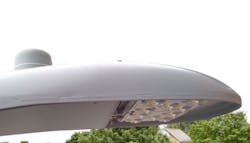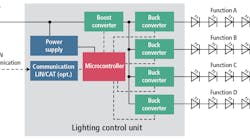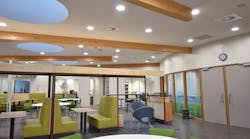Doncaster’s Smartlight Project, Incorporating Telensa’s PLANet System for Wireless street light Control, will Save £1.3m and 8.7m Kilowatt Hours of Energy per Year
Cambridge – Telensa, which provides end-to-end smart city solutions using its low power UNB wireless technology, has announced that a major new deployment is underway covering 33,000 LED street lights in Doncaster, UK. The deployment is part of Doncaster Council’s Smartlight project that will see existing lights replaced by LED luminaires from Urbis Schréder. The new LED street lights are wirelessly connected and managed using Telensa’s PLANet system, ensuring lighting levels are set correctly and power consumption is accurately recorded. Doncaster’s Smartlight project will deliver savings of approximately £1.3m annually by reducing energy consumption by 8.7m kilowatt hours and carbon emissions by 4700 carbon tonnes. Doncaster Borough covers 200 square miles and is home to over 300,000 people.
Cambridge – Telensa, which provides end-to-end smart city solutions using its low power UNB wireless technology, has announced that a major new deployment is underway covering 33,000 LED street lights in Doncaster, UK. The deployment is part of Doncaster Council’s Smartlight project that will see existing lights replaced by LED luminaires from Urbis Schréder. The new LED street lights are wirelessly connected and managed using Telensa’s PLANet system, ensuring lighting levels are set correctly and power consumption is accurately recorded. Doncaster’s Smartlight project will deliver savings of approximately £1.3m annually by reducing energy consumption by 8.7m kilowatt hours and carbon emissions by 4700 carbon tonnes. Doncaster Borough covers 200 square miles and is home to over 300,000 people.
Telensa’s PLANet smart city system consists of telecells plugged into each street light, which connect wirelessly to a cloud-based control application via a small number of street light-mounted base stations. The central system ensures that street lights are set to the optimal level for each area and time of night, so that all areas are safe and well lit. Additionally, because the street lights are connected, local lighting levels can be continuously adapted throughout their 25-year expected lifetime. The system accurately records the power consumption of each street light, allowing the council to ensure that it only pays for the energy consumed. The project is expected to reduce the council’s lighting energy bill by half while also providing an improved quality of light.
Telensa is the world leader in wireless street lights, with projects covering a footprint of over 1 million street lights worldwide. By connecting lights through a low-cost wireless network, further IoT applications can also be added quickly and cost-effectively. These include using connected street lights as a communications hub for sensors such as traffic or air quality measurement, to connect new control applications such as smart parking, or integrating lighting-based analytics with other smart city systems.
“We’re delighted that our wireless PLANet Central Management System is a part of Doncaster’s ground-breaking Smartlight project,” said Will Gibson, CEO Telensa. “Connecting LED street lights with smart city control is compelling because it pays for itself with extra savings in energy usage and avoiding needless maintenance visits, whilst giving the flexibility to centrally evolve lighting programs over time, future-proofing the LED investment.”
“The Smartlight Project is a fantastic scheme which will result in better quality lighting, a reduced carbon footprint and crucial financial savings for the council.” Mayor of Doncaster, Ros Jones, said. “In a difficult economic climate where other authorities are turning off street lights at night or removing some lighting, ours is a resourceful approach that will maintain lighting while providing savings.”
The Smartlight project, also involving Salix Finance and Eon, is part of an-invest-to save initiative into which the council is investing £8.2m. Thanks to the technology’s energy efficiency the investment is expected to pay for itself within six years.
About Telensa
Telensa makes wireless smart city control applications, including the world’s most widely deployed smart street light solution. Based on a compelling business case with proven scalability, Telensa’s solutions also provide a low-cost platform to add multiple city-wide sensor applications. The company’s smart parking solution includes some of the world’s largest deployments such as Moscow and Shenzhen.
Fundamental to Telensa’s success is its Low Power Wide Area (LPWA) Ultra Narrow Band (UNB) radio system, which has the unique combination of low cost, long range, long battery life and 2-way communication for massive numbers of devices. With over 9 million devices across 30 countries using UNB, it is easy to see why it is fast becoming the deployment standard for smart city control applications.
Together with industry leaders including Cisco, Accenture and BT, Telensa is a founding member of the Wireless Internet of Things Forum (WIoTF). Created to drive standards adoption and establish common wide area smart city approaches, the WIoTF is committed to uniting the growing ecosystem and accelerating the adoption of wide-area wireless IoT. (www.wireless-iot.org)
Contact:
Richard Howson - for TelensaE-mail:
[email protected]Web site:
www.telensa.comLocate more driver & controls vendors in the LEDs Magazine Suppliers Directory
Submit new products, case studies/projects, and other press releases at http://www.ledsmagazine.com/content/leds/en/addcontent.html.
More from Telensa:
Telensa appoints additional smart lighting personnel to US team to support contract wins
Wireless street lighting control company Telensa appoints Karen Balbi as product manager





